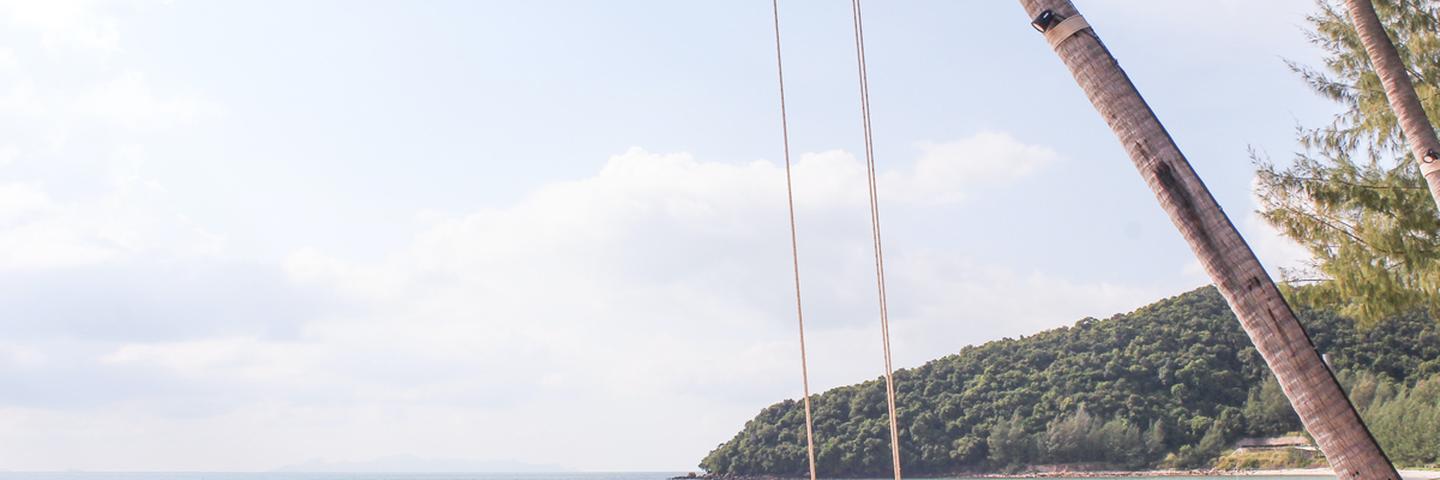Are you planning a trip to Thailand and finding it a bit tricky to figure out the ideal duration for your stay? No worries, we've got your back. Drawing from our extensive experience exploring Thailand over numerous visits, we totally get the dilemma of deciding how many days to spend in Chiang Mai.
With its incredible history, delectable cuisine, sun-kissed beaches, breathtaking natural beauty, and splendid architecture, Thailand has an irresistible pull. But, how long to spend in Thailand?
14 days is the optimal amount of time for a well-rounded experience in Thailand. This allows you to explore the vibrant cities, immerse yourselves in local culture, explore breathtaking landscapes, discover amazing wildlife and unwind on stunning beaches.

With countless trips to Thailand over the past decade, this charming country has become a second home for us. Our extensive stays have allowed us to fully immerse ourselves in its wonders. Thailand holds a special place in our hearts, revealing new surprises each time we visit.
However, even though it might appear simple to travel around this relatively small country, the truth is that its attractions are spread out. To really make the most of your trip and explore beyond just one place, careful planning ahead of time is essential.
Thailand offers a wide range of outdoor experiences, from captivating temples and pristine beaches to stunning mountains and world-famous cuisine. The friendliness of the locals, always wearing bright smiles, adds to its charm. So, how much time should you consider spending in Thailand to truly experience it? Well, the answer can vary.
For those visiting for the first time, it's a good idea to allocate enough time to see the must-visit places. For those who have been before, the focus might shift towards the places that left an impression on them.
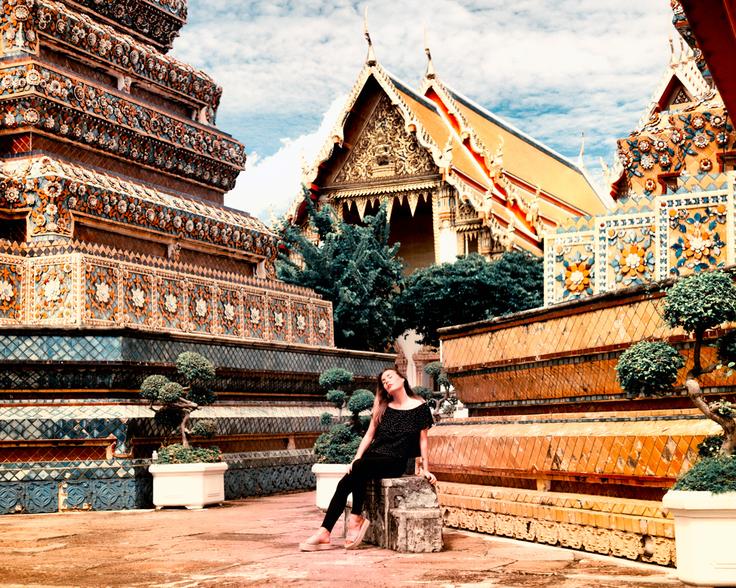
Drawing from our personal experiences in Thailand, we've figured out the perfect timeframe to really capture the essence of the country. This led us to create a comprehensive two-week itinerary for Thailand.
This well-thought-out guide covers Thailand's culture, its beaches, and temples, and even provides a glimpse into its nightlife.
Whether you're embarking on a 14-day journey with your family, a partner, or going solo, our carefully planned itinerary spans the Central, Southern, and Northern regions and can be tailored to your preferences. When you need expert advice and essential information, our meticulously curated guide is the resource you can rely on.
How much time should you spend in Thailand?
If you're looking to really experience all that Thailand has to offer, it's a good idea to plan for at least two weeks. This timeframe gives you the flexibility to explore more than just one region, which is important because travelling from one part of Thailand to another often involves a flight or a long train journey. While these transitions are necessary, they can take up a significant amount of your exploration time.
If you only have one week available for your trip to Thailand, don't worry – there's still plenty to see and do. However, it's worth recognising that this shorter duration won't allow you to cover as much ground as you could with a more leisurely two-week stay.
In this situation, you'll need to make choices – maybe skipping certain attractions, leaving out specific places you wanted to visit, or carefully managing the time you spend in each city.
However, no matter how long you stay in Thailand, there's a valuable tip that can truly enhance your travel experience: learning some of the local languages.
Apart from helping you get around, having conversations with local people opens up opportunities to learn about the native culture, ancient traditions, and hidden gems that aren't crowded with tourists.
Luckily, there are various ways to learn Thai, and using language apps is particularly convenient. They let you go at your own pace and choose your own schedule, making the process more flexible.
At first look, setting aside two weeks for a trip to Thailand might seem like plenty of time, especially if you're from a large country like the US or Australia.
However, Thailand has so much to offer – from its wide range of places to visit to the details of getting around – it's anything but small in scope. In truth, a mere two weeks only lets you scratch the surface.
Why Two Weeks in Thailand is the Perfect Trip
The search for the right amount of time to truly enjoy what Thailand has to offer has resulted in numerous articles, much like the grains of sand on its beaches. However, the truth isn't all that glamorous; it depends more on your personal preferences and eagerness to explore than on Thailand itself.
With the knowledge of a seasoned traveller and a good understanding of the local language, we can achieve in a week what might take others a month to accomplish in Thailand.
On the other side of the coin, considering the variety of captivating places across Thailand's landscape – my simple breakdown being "the Islands," "the North," and "Bangkok" – a two-week journey seems like a well-fitting choice.
This arrangement usually gives around 3 to 4 days to the bustling energy of Bangkok, leaving plenty of time to evenly split your focus between the tropical allure of the south and the lush charm of the north.
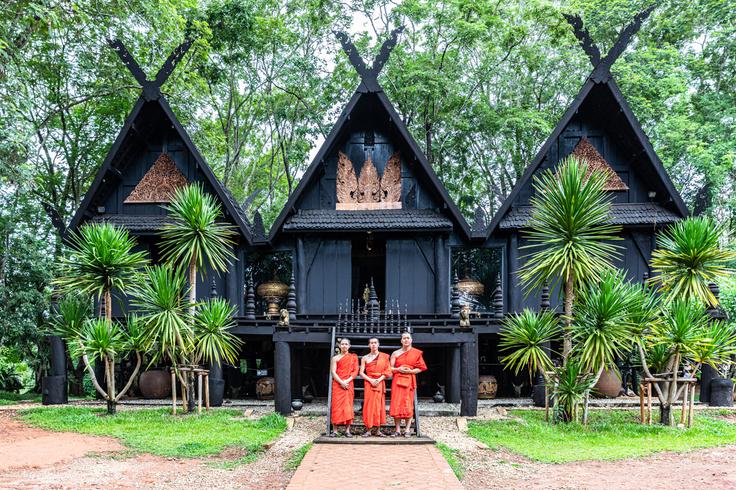
From our own experiences, we can confidently say that Thailand is a treasure trove that's worth every moment invested. Maybe we're a bit biased, considering Thailand holds a special place among our favorite countries worldwide.
And trust me, most people who step foot on its soil will feel the same – it's an awe-inspiring nation that even sparks excitement during the planning stages (at least for those of us who love planning).
The food goes beyond just being nourishment, the locals truly live up to their reputation for friendliness, and those picture-perfect scenes you've seen online? Get ready, because they're even more enchanting in person.
With landscapes ranging from the northern peaks to the southern islands, and the sprawling urban spectacle of Bangkok at its heart, Thailand reveals itself as a land full of diverse views, a multitude of flavors, and surprises waiting around every corner. And let's not forget the wide array of activities ready for you to discover in Thailand.
Your budget will stretch surprisingly far, you won't find yourself bored, and you'll be consistently amazed at every twist and turn. But let's shift the focus from my admiration for Thailand's brilliance and delve into the specifics – let me help you plan your own adventure in Thailand and outline the exact wonders that are waiting for you in this captivating country.
When is the best time to visit?
When it comes to the question of when to set foot in Thailand, you're welcome any time of the year. However, depending on when you travel to Thailand th weather may be very different. Let's break it down season by season:
Wet Season (November - February)
During the months spanning November through February, Thailand dips into a milder climate. It's the cool season, and with the mercury more reasonable, many folks find this stretch optimal for exploration.
Surprisingly, this is when tourists come flocking. You see, the humidity backs off a bit, making for a cozier atmosphere, hence the appeal. If your agenda leans toward active adventures, this could be your sweet spot.
Dry Season (March-May)
Now, if the idea of basking in the warmth of the blazing sun and soaking up the coastal vibes by the beach fills you with delight, the hot season from March to May might be your calling. While the humidity and heat might deter some, the sea breeze and the laid-back beach ambience make this time bearable, even enjoyable for many.
Green Season (May - October)
For those captivated by lush landscapes and verdant vistas, the green season—stretching from May to October—is your jam. The land wears its green coat most vibrantly now, but be prepared for rain. While the downpours come and go, interrupted by sunny interludes, this is when much of the countryside flourishes.
Here's the deal: Thailand's a year-round playground, each region having its own style of weather play. There's the hot season from February to June in central Thailand, while the north experiences its heatwave from February to April. Central Thailand gears up for rain from June to October, while the north has its rainy spell from May to September.
Now, the islands—they've got a two-act show. Islands in the Gulf of Thailand (Koh Tao, Koh Phangan, Koh Samui) save their dry spells for January through August. On the flip side, the Andaman Coast islands (Phuket, Krabi, Phi Phi) revel in their dry season from November to March.
But let's circle back to the golden moment: November to February. These shoulder seasons not only deliver prime weather throughout Thailand, they also manage to sidestep the heaviest crowds. It's a win-win that lets you experience Thailand at its best while relishing a slightly more serene backdrop.
Burning Season and Why to Avoid It
It's essential to bring up the burning season, particularly if you're planning a visit to Northern Thailand. This period, which generally occurs from February to April, can significantly impact your experience. During these months, farmers and locals engage in agricultural burning to prepare fields for the upcoming growing season.
Unfortunately, this practice often results in thick haze and air pollution, creating poor air quality that can be detrimental to health and severely impact visibility. Avoiding the burning season is not just about comfort; it's a critical health consideration.
The polluted air can lead to respiratory issues and discomfort, detracting from the joy of exploration. To fully appreciate the beauty of Northern Thailand's landscapes and maintain your well-being, it's advisable to steer clear of this period and plan your visit during the cooler, clearer months.
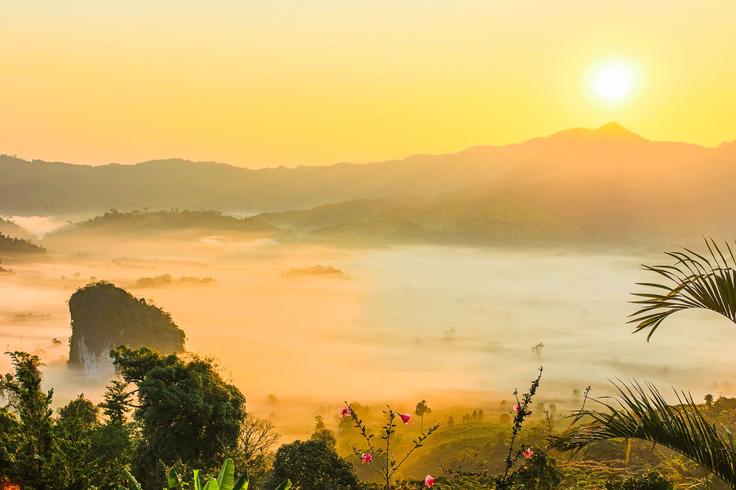
How to Get to Thailand
Thailand is like a starting point for exploring Southeast Asia, and getting here is made simple by Bangkok's central role as a regional hub.
No matter if you're coming from far away or just a neighbouring country, Thailand has six international airports – in Bangkok, Chiang Mai, Phuket, Koh Samui, Krabi, and Hat Yai – all ready to welcome you.
If you're up for a land-based adventure, you've got options for overland travel from Cambodia, Laos, and Myanmar. For a truly fascinating experience entering Thailand from Laos, we personally recommend checking out the two-day boat journey downstream from the charming city of Luang Prabang.
How to Get Around Thailand
Getting around in Thailand is all about finding the right approach that fits your needs. How you get from one place to another depends on where you're starting and where you're headed.
If you're up for flying, it's a breeze to travel between major Thai cities. You've got vibrant Bangkok, peaceful Chiang Mai, and those tempting larger islands like Phuket and Koh Samui, all easily reachable by flight.
But if you're more into overland journeys, there's a charm in embracing the roads. Buses and trains become your trusty companions for most of your travels between cities in Thailand.
And when you're ready to explore the islands, no worries – there's a reliable ferry schedule that can take you from one beautiful spot to the next. And even if you're planning to hop around several islands, there's a neat trick. You can book combined bus, train, and ferry tickets that make the whole process smooth and simple.
The Ultimate most authentic 2-week Thailand itinerary for everyone.
Bangkok: 3 Nights
We suggest spending at least three nights here. Bangkok is huge, home to over 9 million people! It's a buzzing city with tons of things to offer.
You can explore beautiful temples, cruise through canals on boats, enjoy sunset views from rooftop bars, do lots of shopping, and experience the lively Khao San Road where the party never stops!
In Bangkok, traffic is insane, so ensure you pick a centrally located hotel so that you don’t have to suffer the pains of big traffic jams.
Must do things in Bangkok
As we mentioned above there are hundreds of things to do and see in this lively city, however, we suggest that unmissable experiences in Bangkok include exploring the Grand Palace and the Temple of the Emerald Buddha, cruising through the river canals, discovering Wat Arun and Wat Pho temples, exploring night street food markets, enjoy the spectacular sunsets from a sky scrapper, strolling along Khao San Road and Chinatown at night after sunset.
Not least importantly, it is for us essential to emphasise to you guys that Bangkok is “the” destination for foodies ( that’s why we love it so much), boasting so much beautiful food, from street food to Michelin-rated restaurants. We recommend the following schedule:
Day 1 The Grand Palace (Wat Phra Kaew) and Chinatown
On your first day, go ahead and drop your luggage at your accommodation of choice, freshen up and head straight to The Grand Palace and temple of the Emerald Buddha. As you go towards this area you will find plenty of street food and cafes available to have a meal or a refreshing Thai Milk tea!

Since 1782, the Grand Palace has stood as the esteemed abode of the Kings of Siam, now Thailand. Within its vast expanse lies a multitude of structures and pavilions, with the Temple of the Emerald Buddha, known as Wat Phra Kaew in Thai, taking centre stage.
As with all temples and sacred places in Thailand, it is essential to remember that there is a dress code to enter those sites. It includes covering both shoulders and legs, no cleavages no shorts and overall conservative attire. We always have a sarong with us in case we need to use it. Most places do have sarong rentals within these complexes for 1- or 10 baht.
When it comes to the price for The Grand Palace, the non-national price is 500 baht and you can get the ticket right there in the place but if it is more comfortable for you and you wish to skip the waiting line you could also buy it online.
Getting settled, walking around, getting a couple of meals/ drinks, reaching the grand palace and exploring it fully, should definitely cover most of your first day. Lastly, indulge in amazing food with the vibiest atmosphere at BKK Chinatown!
Chinatown Bangkok
After a full day of exploration, we recommend you check out the vibrant Chinatown for your dinner meal. Bangkok's lively Chinatown, situated mainly along Yaowarat Road and extending across several blocks is a must-see!
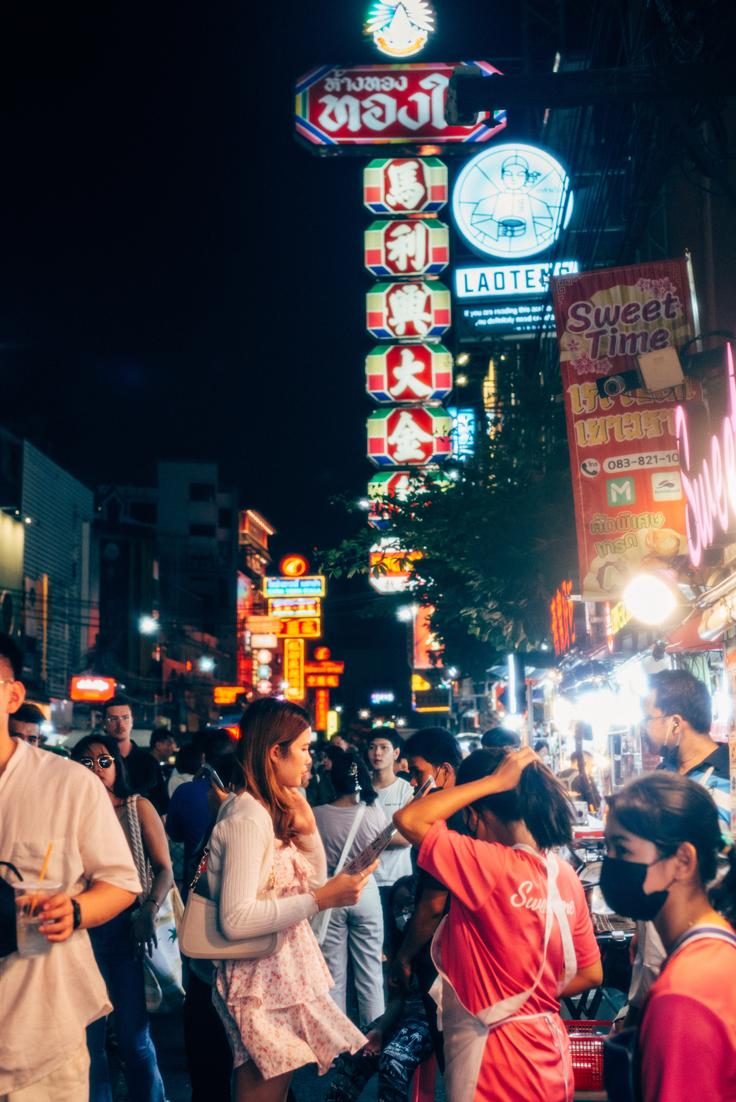
It is like being in China but in Thailand, you will be amazed by the bustling vibes of shops, traffic, lights and food, lots of food!
For a visual touch, we suggest you grab a tuk-tuk to get in Chinatown as it gives a whole other vibe, it is super iconic!
We recommend joining the most authentic and fun Chinatown night tour in the entire Bangkok!
Day 2 Wat Arun and Wat Pho
Wat Pho
Founded during the reign of King Rama I, this temple complex stands as one of Bangkok's oldest and most significant landmarks.
A staggering 394 gilded Buddhas and more than 1000 Buddha images grace the four surrounding complexes, making this one of Bangkok's most ancient and grandest temples.
Originally this site was intended to serve as a centre for both learning and spirituality, housing a renowned traditional Thai massage school within its grounds.
It welcomes visitors from 8 am to 5 pm, Wat Pho charges an entrance fee of 100 baht.
Wat Arun
Nestled gracefully along the western banks of the Chao Phraya River, The Temple of Dawn (Wat Arun), stands as an embodiment of splendour.
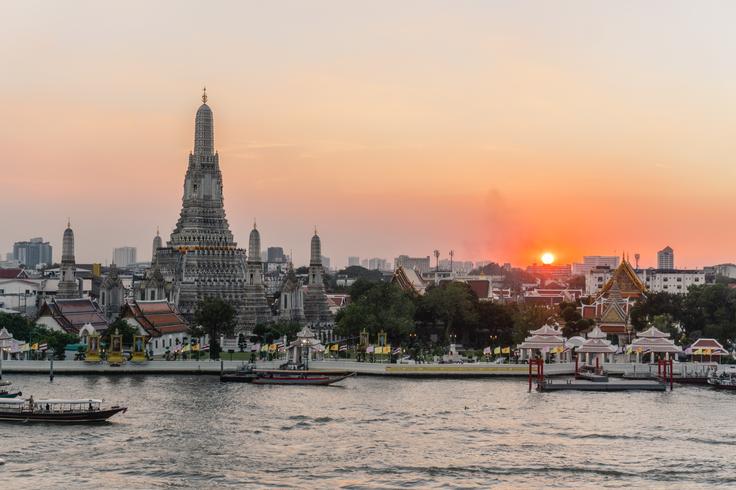
This is our favourite temple to be seen and a must-see gem in Bangkok, the temple's soaring view from the top is awe-inspiring.
To ensure a smooth visit, it's advisable to confirm its operational hours, typically spanning from 8 or 9 am to 4:30 or 5:30 pm.
Tickets, priced at 100 baht for visitors, can be acquired either at the gate or conveniently online in advance as sometimes the waiting line can be quite annoying, and remember Bangkok is sunny and hot!
To make the most out of your time in Bangkok, we recommend you join the most comprehensive temple tour to visit the above mentioned temples properly. It is amazing!
Jim Thompson House
Once the dwelling of American silk producer and art enthusiast Jim Thompson, this compound comprises several traditional Thai houses and structures meticulously saved and restored by Thompson on his premises.

These buildings are preserved in their original splendour, offering a glimpse into Thompson's life. The houses also serve as a canvas for an extensive collection of Southeast Asian art.
The house welcomes visitors daily, from 9 am to 6 pm, even on public holidays. For entry, a fee of 200 baht applies (100 baht for those under 22, while children enjoy free access). Reservations aren't essential you can just show up.
To conclude this awesome day, head across the river via ferry and enjoy the best cocktails and awesome food in one of the rooftop bars with the most perfect views of the sunset over the Wat Arun and the Chao Praya river this will make of your day in Bangkok an absolute dream.
Day 3 Floating Market and Railway Market
Bangkok Floating Markets
We are personally huge fans of markets and street food in Thailand. That is why South East Asia, as a whole, is like paradise for us and more specifically, floating markets are a world to be discovered.
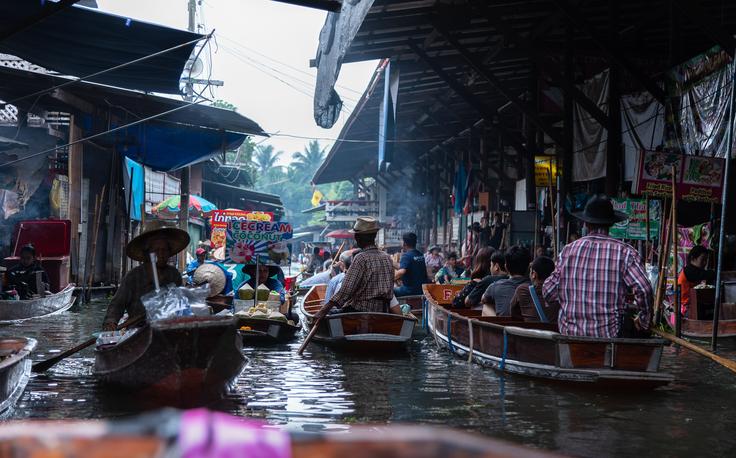
Around Bangkok, there are several floating markets but we do recommend checking out Damnoen Saduak Market to get the local and traditional vibe mixed with a bit of a touristy atmosphere!
Damnoen Saduak Floating Market
You will need to get the tickets here and arrange for a guided tour as it is otherwise not possible because they have to take you on a local boat to go through the canals.
As you arrive, you will see tons of boats gracefully sailing through the water, each full of colourful arrays of fresh fruits, vegetables, and local goodies. It is a very exciting and interesting experience.
We actually always found easier to join the most complete Damnoen Saduak Floating Market and Mae Klong Railway Market tours as local guides will take you exactly to the proper spots and will leave you set for an amazing day.
Railway Market
Mae Klong Railway Market, located a bit further from Bangkok CBD, is also known as Siang Tai (life-risking) Market!
This remarkable spot ranks on top of the index of things to do in Bangkok, and for a good reason. This bustling market is home to the typical variety of goodies, such as seafood, vegetables, fruits, fresh and dried foods, meats, and other delights.
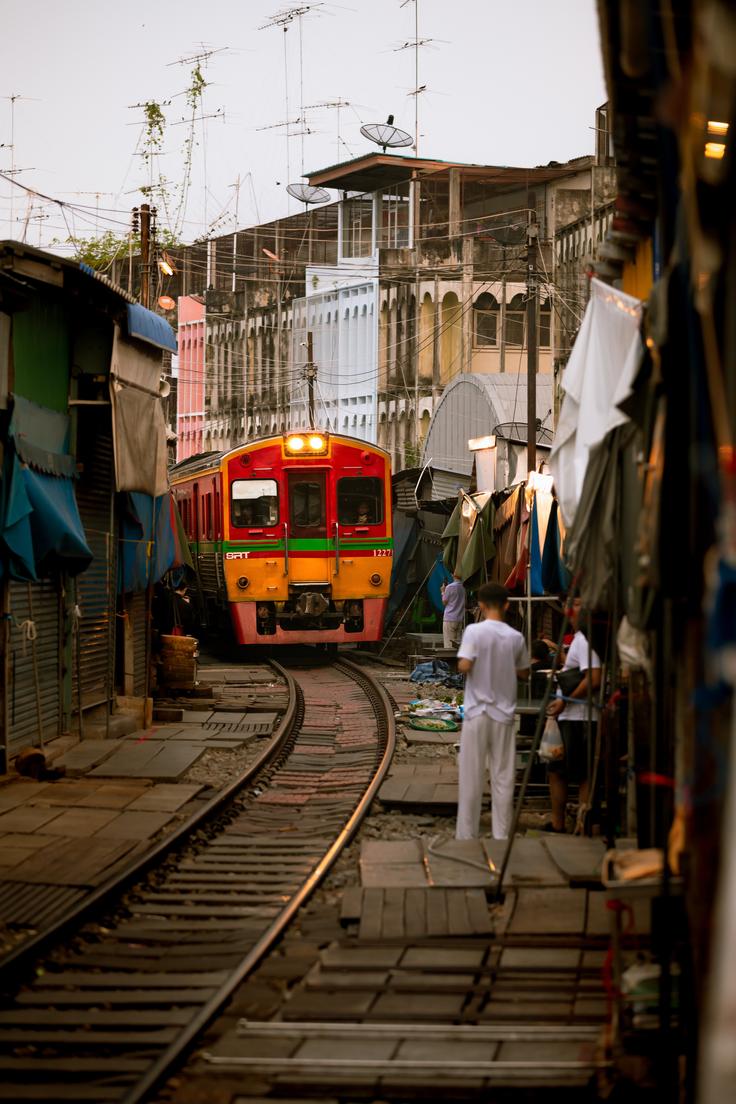
However, its unique set-up is what makes it so incredible due to its stalls being situated right along the Mae Klong-Ban Laem railway line, where vendors ingeniously shield themselves from the sun with parasols and canvas shelters, extending these covers onto the railway space where shoppers walk.
When the signal for an approaching train sounds, a scene of organized frenzy unfolds: vendors promptly fold their parasols and canvas, ensuring no obstructions lie in the train's path.
The train swiftly passes through, and just as quickly, parasols and canvas spring back to life as the merchandise is restored to its rightful place alongside the tracks. It is super fascinating!
The perfect cherry on top for this day and to conclude your Bangkok days would be to head to a rooftop bar to enjoy a drink/ meal whilst you contemplate Bangkok’s magical sunsets.
Our recommended places are Vertigo Rooftop and King Power Mahanakhon.
How to get to Bangkok
When travelling to Thailand, the journey often begins and ends at Bangkok's major international airport, Suvarnabhumi Airport (BKK). However, there's another airport in Bangkok, Don Mueang (DMK), which serves both domestic and international flights.
It is important to note that these two airports are not conveniently close, so when planning connecting flights or your arrivals and departures, careful attention is needed to ensure a smooth transition.
How to get around Bangkok
We can recommend enough the use of Grab in Thailand. This is a reliable and wallet-friendly option, very similar to the Western app Uber. You can grab a SIM card at the airport or local convenience stores to stay connected for like 600 baht or less which is 20$.
If you prefer hailing a taxi off the street, you can do this too, however, note that some drivers might resist using the meter for foreign passengers, so don’t be shy to respectfully haggle.
For an exciting and old-time Bangkok experience, hop on a tuk-tuk. These three-wheeled wonders are pricier than other options, but they come with a side of entertainment.
While tuk-tuks are perfect for short jaunts, keep in mind that you'll need to agree on the fare upfront, giving you a taste of local negotiation skills.
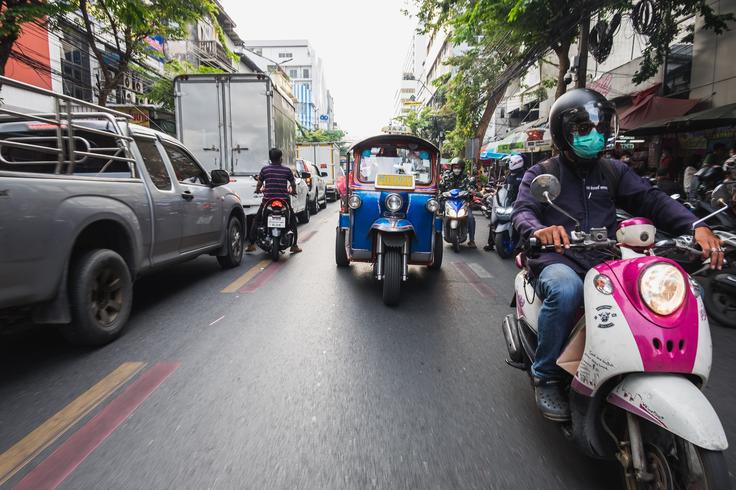
Where to Stay in Bangkok. Our top recommendations:
GO INN Khao San Road
Having spent time in numerous hotels across Bangkok, we've got quite a catalog of places to recommend! For a first-timer in Bangkok, we'd suggest checking out GO INN Khao San Road – it's a fantastic choice.
It is quite affordable and close to Khao San Road the iconic area and also a hotspot to commute to explore the city.
For a more mid-range regime, and in Bangkok mid-range hotels are super affordable! We definitely recommend you check out:
Casa Vimaya Riverside
This is a charming boutique hotel nestled along the banks of the Chao Phraya River in Bangkok with an elegant Thai-inspired design and tranquil atmosphere!
The rooms are super spacious featuring traditional decoration and an incredible river view!
Lebua at State Tower
Lastly, if you are not so tight in your budget we definitely recommend you treat yourself in one of the best hotels in Bangkok. It is a little more upscale but it is so worth it.
Lebua at State Tower is a luxury hotel soaring high above the Bangkok skyline known for its iconic rooftop bar, Sky Bar, which offers breathtaking panoramic views of the city.
The suites are incredible! elegantly designed, offering modern amenities and stunning vistas. With multiple dining options, including the renowned Sirocco restaurant, guests can indulge in a range of culinary delights. It is so so worth it!
Chiang Mai: 4 Nights
Chiang Mai stands as one of Thailand's top tourist and digital nomad destinations. This is due to the wide range of temples and attractions within the area all of it surrounded by a friendly and affordable atmosphere. This is the reason why we advise spending 4 nights in Chiang Mai to get the most out of it.
This will allow you to explore the most popular and beautiful temples in the country, discover the amazing local night markets, interact with gentle giants at elephant sanctuaries, explore nearby historical cities and overall discover the North of Thailand leaving you in an awe moment.
Must do things in Chiang Mai
Chiang Mai's Old Town serves up a visual feast of opulent temples harmoniously juxtaposed between quaint coffee shops, artisanal boutiques brimming with handmade treasures, and exquisite dining establishments.
Among the 160-plus temples in Chiang Mai, there are some unmissable and prominent ones like Wat Chedi Luang, Wat Phan Tao, and the cherished gem, Wat Rajamontean.
In fact to get a in-depth view of Chiang Mai and since time is a bit precious here, we recommend you join the best local temple hunting tour to ensure you see the most beautiful temples and you don't waste time finding them!
Beyond the urban landscape, the northern reaches of Chiang Mai boast picturesque small towns, rice terraces, mountain temples, and cascades. Not to mention the incredible sanctuaries where you can engage with rescued elephants in an ethical manner. Let’s break it down:
Day 1 Wat Chedi Luang, Wat Lok Moli, Wat Rajamontean, Wat Phra Singh
Exploring the temples of Chiang Mai is a truly amazing experience. There are more than 160 temples, each one a unique masterpiece of architecture and design, adorned with intricate details, vibrant colours, and a serene ambience that invites contemplation.
Amongst the must-see temples on your first day in Chiang Mai, you should visit:
Wat Chedi Luang
Wat Chedi Luang, tucked away in the heart of Chiang Mai, is a mesmerising glimpse into the past. This temple is one of the oldest in Chiang Mai. Its centrepiece is its towering chedi, an ancient masterpiece that stands as a testament to the city's history.
As you explore, the intricate carvings and weathered textures of the chedi's surface reveal a story etched in stone.
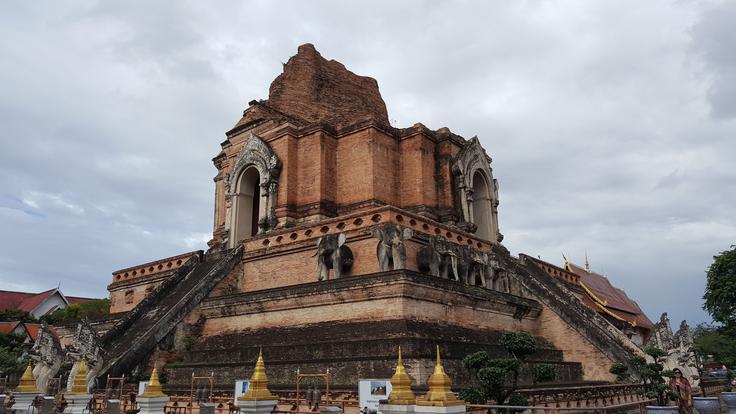
Wat Lok Moli
Wat Lok Moli, situated in Chiang Mai's Old City, stands out for its blend of Lanna and Burmese architecture. It features a main hall with a prominent seated Buddha statue and intricate murals showcasing Buddhist stories.
What's unique is its viharn, characterised by an open design with tall teak pillars, reminiscent of Burmese temples. The temple's exterior boasts detailed stucco work. Set in a tranquil environment, Wat Lok Moli offers a quieter and contemplative experience compared to more famous temples.
Wat Rajamontean
Wat Rajamontean, nestled in Chiang Mai's Old City, is a hidden gem set apart from other temples as its main hall houses a revered female Buddha image, exuding a sense of tranquillity and reverence.
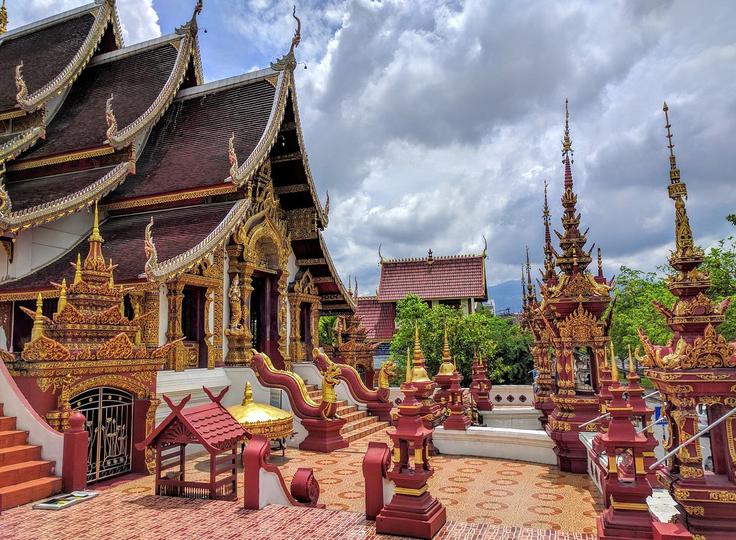
Wat Phra Singh
Wat Phra Singh, situated at the heart of Chiang Mai's Old City, is a revered temple that exemplifies the grandeur of Lanna architecture. Its striking features include a magnificent main hall, intricately designed with golden accents and elaborate motifs.
The temple houses the sacred Phra Singh Buddha image, a symbol of deep devotion and spirituality. Surrounding the main hall, the temple grounds provide a serene setting adorned with lush gardens and serene courtyards.
After a bustling first day in Chiang Mai, unwind by exploring the city's lively street markets. This is by far our favourite thing to do in Chiang Mai. Delving into Chiang Mai's street markets goes beyond shopping for souvenirs and savouring delicious budget-friendly meals. These markets are deeply rooted in Thai culture, offering you another avenue to truly connect with the essence of the country.

Day 2
On your day 2, you will be walking through more of these sacred places, feeling the sense of wonder and reverence, as well as a deep appreciation for the artistry and devotion that went into creating them.
Wat Cha Man
Wat Cha Man, located in Chiang Mai's Old City, is a lesser-known temple that holds historical and artistic significance. Built during the late 15th century, this temple boasts distinctive architecture that marries Lanna and Burmese influences.
Its main hall showcases a revered Buddha image known as Phra Sihing, a representation of devotion and veneration for locals.
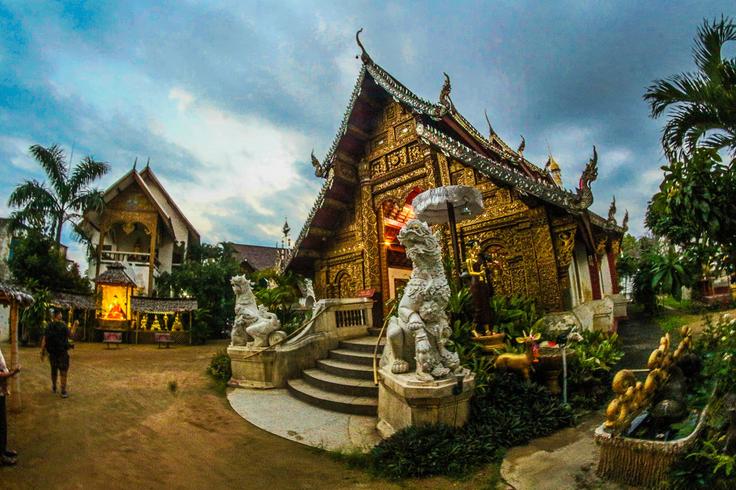
Wat Sri Suphan
The Silver Temple, officially known as Wat Sri Suphan, is a unique and must-visit temple in Chiang Mai. Its most striking feature is its intricate silver exterior, which reflects light in a dazzling manner. The temple's ornate silverwork encompasses the entire structure, making it a true masterpiece of craftsmanship.
Constructed over 500 years ago, Wat Sri Suphan holds deep historical and cultural significance. The temple's interior continues to mesmerize with intricate silver detailing and beautiful murals depicting religious stories.

Wat Phra That Doi Suthep
Wat Phra That Doi Suthep, often referred to simply as Doi Suthep, is a revered Buddhist temple perched on a mountainside overlooking Chiang Mai. This iconic temple is a prominent symbol of the city and a significant religious site in Thailand.
To reach the temple, you will have to ascend a staircase adorned with elaborate dragon railings, offering a sense of spiritual ascent whilst making a bit if an effort to climb the mountain!
The main attraction of Doi Suthep is its stunning golden chedi, which enshrines a relic said to be a piece of the Buddha's shoulder bone.
The chedi is beautifully adorned with intricate designs and is a beacon that displays beauty against the backdrop of lush greenery. The panoramic views from the temple's terrace are breathtaking, showcasing the sprawling cityscape and surrounding mountains.
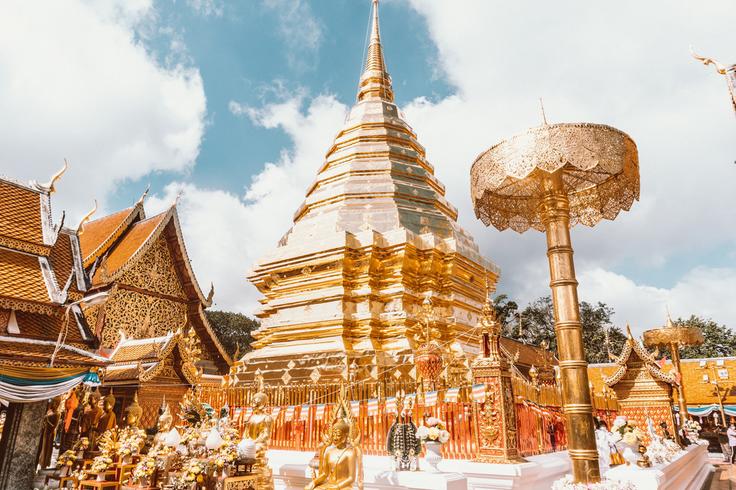
Day 3 Chiang Rai
On your day 3 you definitely want to visit Chiang Rai, a nearby small town that is the small and less crowded version of Chiang Mai with a unique touch.
It is only about 3 hours away by bus from Chiang Mai and it is totally worth it. We would recommend you spend the night in Chiang Rai but coming back to Chiang Mai is also totally possible.
We definitely recommend joining the best guided tour by expert locals to ensure you make the best out of your day trip in Chiang Rai. On top of that they will cover your lunch time with the best Thai food ever! You will be visiting:
Wat Rong Khun
Wat Rong Khun, also known as The White Temple, is an extraordinary and unconventional temple located in Chiang Rai. It is renowned for its unique and modern design, the temple is characterized by its gleaming white exterior that shines brilliantly against the sky. Designed by artist Chalermchai Kositpipat, the temple's intricate details and symbolism make it a true work of art.
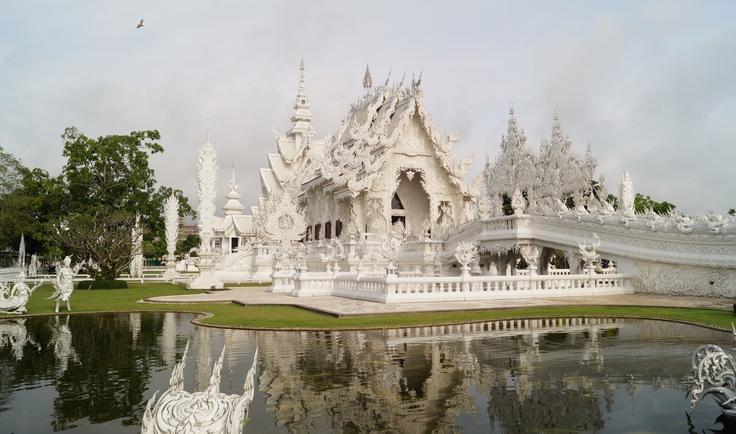
Wat Rong Suea Ten
Wat Rong Suea Ten, also known as The Blue Temple, is an amazing and relatively newer temple located in Chiang Rai. As its name suggests, the temple is characterised by its striking blue exterior that sets it apart from other traditional temples.
Designed by artist and local painter Ajarn Chalermchai Kositpipat, the temple's intricate details and vibrant colour scheme create a truly mesmerizing sight.
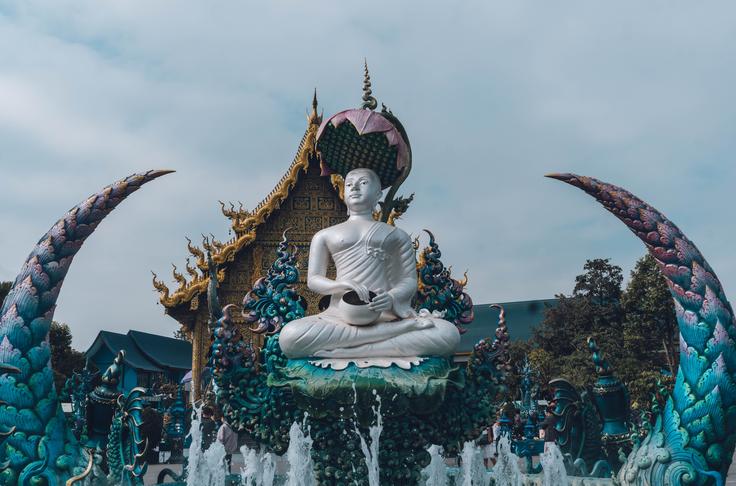
Similar to the White Temple, the Blue Temple is a fusion of traditional Buddhist artistry and contemporary design elements.
The temple's aesthetic is a testament to the artist's unique vision, which aims to create a spiritual sanctuary that resonates with modern sensibilities.
Wat Phra Kaew
The Big Buddha of Chiang Rai, officially named Wat Phra Kaew Chiang Rai, is an awe-inspiring and revered monument in the form of a towering height of 25 meters (82 feet) surrounded by serene landscapes, this colossal statue of Lord Buddha stands as a symbol of spirituality and cultural significance.
In fact, this is another perfect example of an incredible temple showcasing the female image of Buddha. The statue's radiant white exterior stands in stark contrast to the lush greenery of its surroundings, creating a striking visual impact.
Day 4 Elephant Sanctuary Chai-La Orchid
Visiting an elephant sanctuary is a popular and ethical activity that allows you to interact with these majestic creatures in a responsible and humane manner.
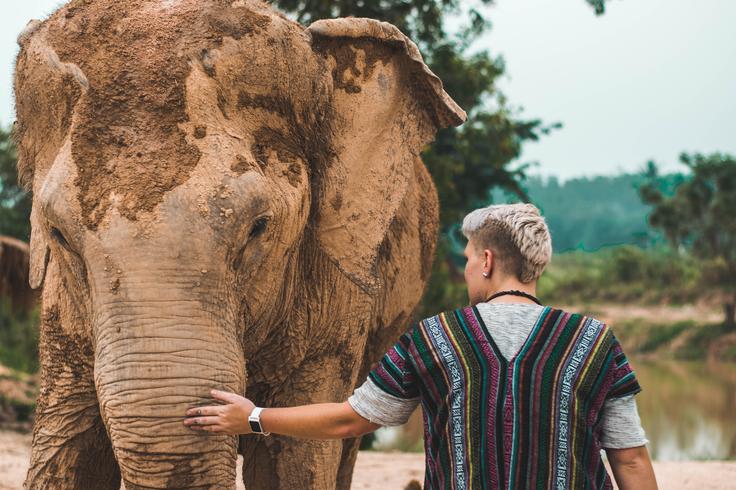
Chiang Mai is known for its elephant sanctuaries that offer a chance to observe, feed, bathe, and even walk alongside elephants in their natural environment.
We recommend you check out one of the most caring and amazing ethical elephant sanctuaries in Chiang Mai. We had the time of our lives.
How to get to Chiang Mai
Getting to Chiang Mai is a breeze with several transportation options. If you're coming from afar, flying is the most common choice. Chiang Mai International Airport (CNX) caters to both domestic and international flights, offering connections to major Thai cities and Asian destinations.
Airlines like Thai Airways, AirAsia, and Bangkok Airways provide regular flights. Upon arrival, taxis, Grab services, and airport shuttles await for your onward journey.
For a scenic adventure, consider the train journey from Bangkok. While it takes around 11-14 hours, the experience is memorable, taking you through captivating landscapes. Sleeper options offer comfort for overnight travel.
Buses also link Bangkok and Chiang Mai, taking 9-12 hours. VIP buses with reclining seats provide varying levels of comfort, though the lengthy trip might be tiresome.
A road trip enthusiast? Embark on a car journey, taking 9-10 hours from Bangkok. The highway boasts decent quality and allows stops along the way.
If you're already in Thailand, domestic flights from places like Phuket and Krabi offer convenient access. Additionally, travel agencies offer package deals encompassing transportation to Chiang Mai, ensuring a hassle-free experience.
How to get around Chiang Mai
Getting around Chiang Mai is easy as pie thanks to its wide range of transportation options. Tuk-tuks offer that classic experience, but remember, haggling upfront is the name of the game. Songthaews, those colour-coded shared taxis, stick to set routes, while the red trucks act like communal cabs.
If you're up for it, renting motorbikes gives you freedom, but do keep an eye out in traffic. And since Chiang Mai is a pretty bike-friendly place, bicycles are a great option, especially for exploring the city centre.
You can also use the Grab app, which works like Uber and guarantees hassle-free rides. And for those short distances, walking is a fantastic way to uncover the city's charm.
With all these choices at your disposal, you can move around Chiang Mai just the way you like, making your exploration smooth and enjoyable.
Where to Stay in Chiang Mai. Our top recommendations:
White Boutique Hotel and Spa
White Boutique Hotel and Spa in Chiang Mai is a charming retreat offering a blend of modern comfort and traditional Thai elegance.
Located in the heart of the city, it provides easy access to popular attractions like the Night Bazaar and temples. The hotel boasts well-equipped rooms with a touch of local decor. Pretty cute!
Mina Garden Villa Resort
Mina Garden Villa Resort in Chiang Mai is like a peaceful haven surrounded by lush greenery. It's your getaway from the city's hustle and bustle, and the cool part is, it's not far at all from Chiang Mai's main attractions.
The villas here are roomy and beautifully designed – a perfect retreat. Each one comes with all the modern stuff you'd expect and a dash of Thai style.
You'll find tropical gardens, a pool, and a spa in the resort – everything you need to kick back and relax. And when it's time to eat, the restaurant on-site serves up delicious Thai dishes and international flavors.
Mina Garden Villa Resort is awesome if you're looking for a peaceful stay that's still super close to Chiang Mai's cultural gems.
Sila Pool Villa
Chiang Mai offers a luxurious and private retreat for travellers seeking an upscale escape.
This villa is absolutely stunning with modern amenities, including a private pool and outdoor living area, creating a serene haven for relaxation.
Sila Pool Villa provides a secluded experience while still being conveniently located near Chiang Mai's attractions, ensuring a memorable and indulgent stay for guests.
Phuket: 3 Nights
This 3-night itinerary for Phuket will combine beach relaxation, cultural exploration, and island adventures to make the most of your short stay on this beautiful island.
Phuket, Thailand's largest island, is a tropical paradise known for its stunning beaches, vibrant nightlife, and diverse cultural attractions.
With its crystal-clear waters, lush landscapes, and a mix of modern amenities and traditional charm, Phuket offers a perfect blend of relaxation, adventure, and exploration for travellers seeking a memorable getaway.
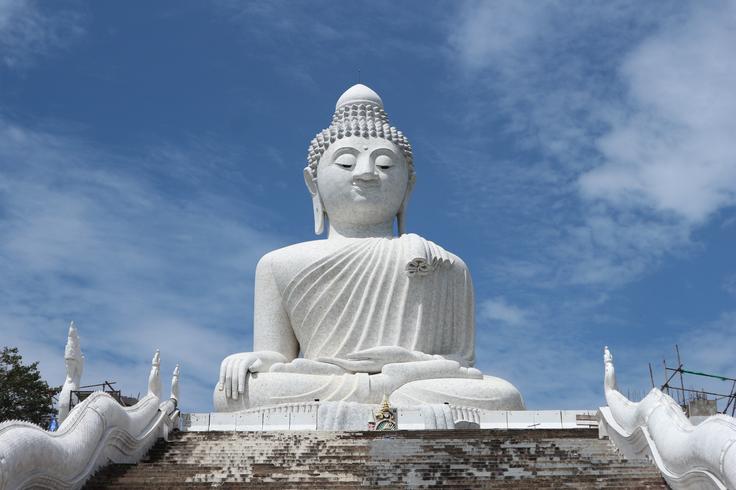
Phuket also carries a touch of history with its charming colonial architecture, particularly in the Old Town area.
To make your life easier, we advise you join a full guided tour around this amazing city, this way you will be hitting the cool spots an a few hours with the bes local guidance.
Strolling through the streets lined with colourful Sino-Portuguese buildings takes you back to the island's colonial past, offering a unique glimpse into its cultural heritage and influences from different eras.
Must do things in Phuket
Day 1: Patong Beach
Upon your arrival at Phuket International Airport, you'll be transferred to your hotel or you will reach it by yourself, where you can drop your luggage and freshen up.
As the day transitions into the evening, take a relaxing stroll along the iconic Patong Beach, soaking in the coastal ambience.
As night falls, delve into the vibrant atmosphere of Bangla Road, known for its lively nightlife full of street food, bars, clubs, and street performances.
Day 2 Phuket Island Exploration
One of the most popular and attractive things to do in Phuket is to dedicate a full-day island-hopping to discover Phi Phi Islands or the iconic James Bond Island.
You will be amazed by the beauty of crystal-clear waters, pristine sandy beaches and dramatic limestone formations that dot the landscape.
As the sun begins to set, return to Phuket, where you have the option to visit the majestic Big Buddha. This revered site offers panoramic vistas of the island and its surroundings.
Day 3: Phuket Old Town
Begin by visiting Wat Chalong, the island's largest and most revered temple, where you can experience Phuket’s approach to spirituality.
Continue your journey by exploring Old Phuket Town, a charming area adorned with vibrant Sino-Portuguese architecture and bustling local markets. It is super amazing and very different to the other areas in Thailand that you would have visited by then.
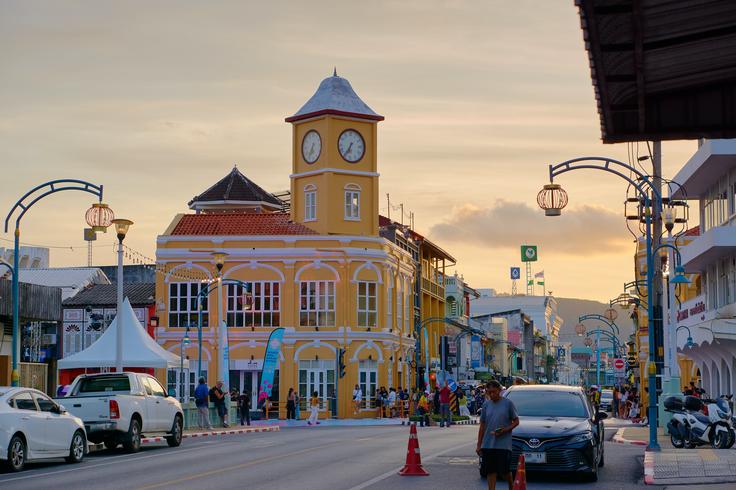
Lunchtime offers the chance to savour authentic Thai flavours at a local restaurant. Afterwards, enjoy a leisurely afternoon at either Kata Beach or Karon Beach, where the golden sands and azure waters invite relaxation. Most beautiful and vibrant areas of Phuket.
For a truly rejuvenating experience, treat yourself to a traditional Thai massage or spa treatment that will soothe your senses. We recommend you try this one.
To conclude your last night in Phuket, explore Phuket's night markets. Wander through the bustling stalls, sample amazing street food, and take in the vibrant atmosphere, you will love it.
How to get to Phuket
Getting to Phuket is a breeze with various transportation options!
Most travellers arrive at Phuket International Airport, which offers both domestic and international flights. From major cities in Thailand to destinations like Kuala Lumpur and Singapore, several airlines like Thai Airways, AirAsia, and Bangkok Airways operate regular flights to Phuket.
If you're already in Thailand, you can also consider taking a bus to Phuket. There are several bus companies that offer services from cities like Bangkok, Krabi, and Surat Thani. The journey can take around 9-13 hours, depending on the starting point.
For a more scenic route, you can take a train to Phuket. Although there isn't a train station on the island itself, you can take a train to Surat Thani or Trang and then continue your journey by bus or ferry to Phuket.
Additionally, if you're in nearby areas like Krabi or Phang Nga, you can easily reach Phuket by road. Car rentals and private transfers are available for a comfortable and flexible travel experience.
How to get around Phuket
Getting around Phuket is hassle-free with a variety of transportation choices. Taxis and tuk-tuks are readily available, while renting a motorbike offers flexibility for independent exploration, as long as you have a valid license and follow safety guidelines.
Shared songthaews follow set routes, providing a budget-friendly option, while local buses offer another economical means of travel. For those seeking convenience, the Grab ride-hailing app operates on the island.
Rental cars are ideal for a personalised experience, with well-maintained roads making driving a viable choice. Ferries connect Phuket to nearby islands and walking or cycling is practical for certain areas like Old Phuket Town.
Where to Stay in Phuket. Our top recommendations:
Deva Moon Phuket
It is an awesome beachfront resort that offers a luxurious and enchanting stay in Phuket. With its stunning ocean views and stylish design, the resort provides a serene escape for travellers looking to unwind in a tranquil environment. Super dope!
Wow Grand Pool suite
The Wow Grand Pool Suite in Phuket is a lavish and opulent accommodation option that offers an exceptional and indulgent stay on the island. And let’s face it! sometimes we simply need a little treat!
The suite provides a truly wow-worthy experience for guests seeking the ultimate in relaxation and comfort. The spacious suite features a private infinity pool that overlooks the stunning ocean views, creating a serene and romantic atmosphere. Try out!
Koh Samui Island: 3 Nights
As you approach the end of your Thailand journey, you have the choice to spend your final nights on Koh Samui.

Koh Samui is known among other things for its array of charming resorts and inviting sandy shores. Additionally, the convenience of the airport on the island eliminates ferry-related stress before your flight. Both destinations hold their charm, making it a delightful dilemma to choose between them.
A recommended stay of 3 nights on Koh Samui allows you ample relaxation, offering serene beaches and fantastic resorts and to get the overall island vibe.
Must do things in Koh Samui
During your three nights on Koh Samui, many travellers opt for the classic pastimes of beachside relaxation and savouring tropical beverages at the hotel's swim-up bar, and we couldn't agree more!
Check out Chaweng Beach as it stands out as a crowd favourite with its expansive shoreline and abundant amenities, even though it tends to get quite busy. Alternatively or in addition, a bit further down, check out Lamai Beach.
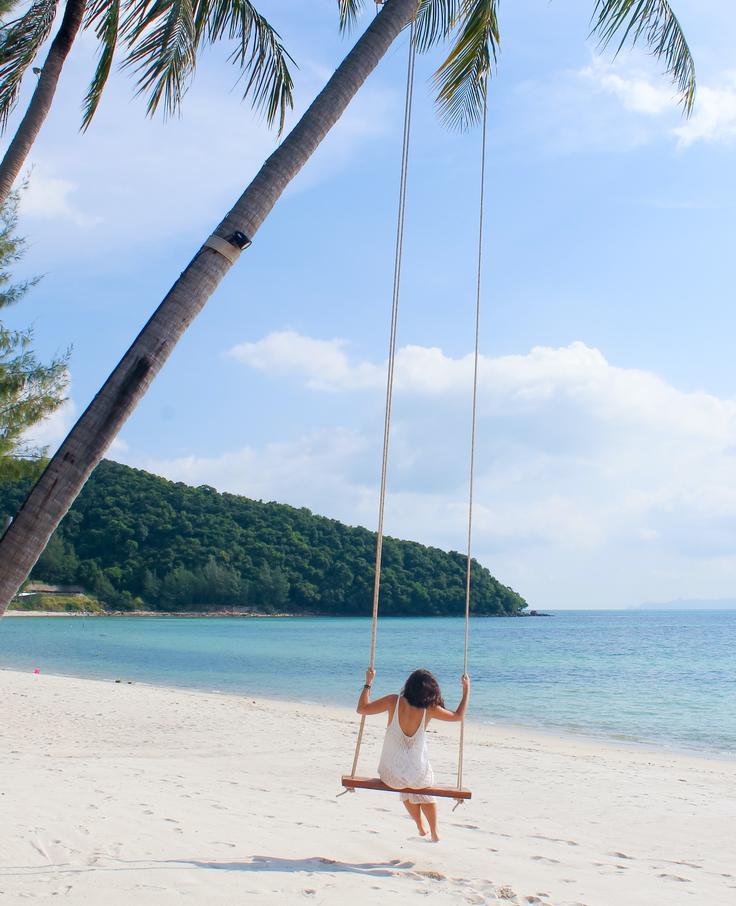
It offers a similarly inviting stretch of sand with a more tranquil atmosphere, while the lesser-known Choeng Mon Beach to the north often steals the hearts of locals as the island's hidden gem.
In Koh Samui, make sure to explore its iconic attractions, including the renowned Big Buddha (Wat Phra Yai), a unique mummified monk, various captivating waterfalls and gardens and all of the beaches!
To acomplish this smoothly and stress free, join the best chill and viby tour guided by locals, you will have ana amazing time.
As the sun sets, an ideal way to unwind is at the beach bars on Bophut Beach and stroll through the vibrant Fisherman's Village where you will be able to thrive in food and drinks!
The Itinerary for these three nights would look like this:
Day 1: Beach Bliss
Upon your arrival in Koh Samui, settle into your chosen accommodation and take some time to relax and freshen up. If you're keen on exploring immediately, head to Chaweng Beach, the island's most popular stretch of sand. Spend your afternoon lounging by the turquoise waters, enjoying beachside activities, and soaking in the tropical atmosphere.
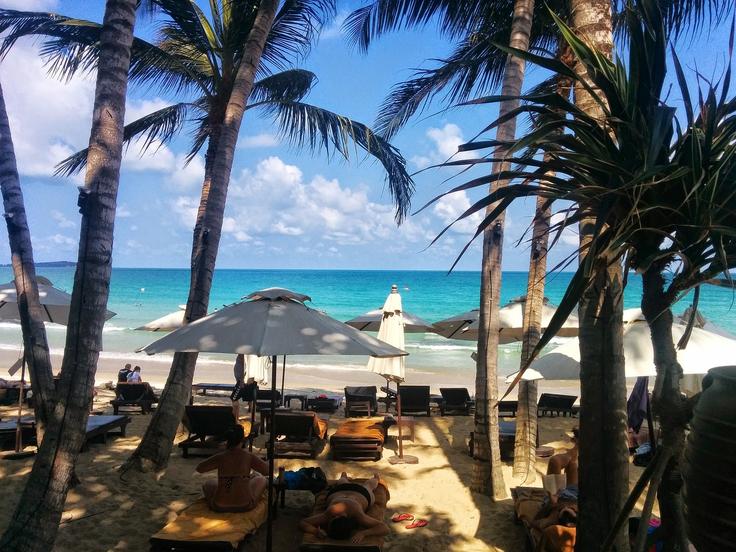
As the day winds down, head to Coco Tam's bar on Bophut Beach for a stunning sunset view and signature cocktails. Afterwards, wander through the Fisherman's Village Night Market, where you can browse through local crafts and try out delectable street food.
Day 2: Island Cultural Immersion
Visit the famous Big Buddha (Wat Phra Yai), a monumental golden statue that offers panoramic views of the island. Next, explore the intriguing Mummified Monk at Wat Khunaram, and then continue to Namuang Waterfall for a refreshing dip in its natural pool.
If time allows, consider a visit to the Secret Buddha Garden or the Samui Cultural Center to delve deeper into the island's culture. In the evening, enjoy a leisurely dinner at a local restaurant and unwind by the beach.
Day 3: Island Relaxation
For your third day, indulge in a leisurely morning at your chosen beach. Depending on your preference, you can head to Lamai Beach for a more serene and less crowded experience, or opt for Choeng Mon Beach for its peaceful charm. Spend the morning sunbathing, swimming, or simply enjoying the tropical surroundings.
In the afternoon, treat yourself to a rejuvenating Thai massage or spa treatment to unwind completely. As the sun starts to set, consider a visit to Wat Plai Laem, a mesmerizing temple complex with intricate architecture and stunning statues.
Round off your final night with a delightful beachfront dinner, savouring the fresh seafood and flavours of Thai cuisine.

How to get to Koh Samui
Getting to Koh Samui is super easy with various transportation choices available. The island boasts its own airport, Samui International Airport (USM), catering to both domestic and international flights.
Direct flights connect major Thai cities like Bangkok, Phuket, and Chiang Mai, as well as international hubs such as Kuala Lumpur, Singapore, and Hong Kong. Renowned airlines such as Bangkok Airways and Thai Airways, along with budget carriers like AirAsia, ensure seamless connectivity.
Alternatively, ferries from mainland ports like Surat Thani and Don Sak, as well as nearby islands like Koh Phangan and Koh Tao, offer scenic maritime journeys. If budget is a priority, combining bus and ferry travel from Bangkok's Southern Bus Terminal is an option.
Train and ferry combinations are also available, though longer in duration. For those already in southern Thailand, renting a car and driving on a ferry is an option. Additionally, domestic flights to mainland ports like Surat Thani can be coupled with a ferry ride.
Many travel agencies and tour operators provide comprehensive packages for a hassle-free journey to Koh Samui, catering to different travel styles and preferences. Your journey to Koh Samui can be as diverse as the island itself, offering a range of transportation modes to suit your needs.
How to get Around Koh Samui
The island features a well-connected network of taxis, both shared and private, providing convenient point-to-point transfers. For a more budget-friendly choice, tuk-tuks are prevalent and offer short-distance rides.
Scooter rentals are popular and give you the freedom to explore the island at your own pace. Keep in mind that road conditions can vary, so caution is advised, especially if you're not an experienced rider. Rental car services are also available, suitable for those looking to venture beyond the main tourist areas.
Public songthaews, converted pickup trucks, serve as shared taxis along fixed routes, offering a cost-effective way to get around. For group travel or guided exploration, consider booking private or group tours, which often include transportation to popular attractions.
Bicycle rentals are an eco-friendly option, ideal for shorter distances and leisurely rides. To experience the coastal beauty, long-tail boats and speedboats are available for island hopping and accessing nearby islets.
Lastly, if you're staying at a resort, many offer shuttle services, making it easy to access the island's attractions. With a variety of transportation modes, getting around Koh Samui is flexible and accommodating to different travel preferences.
Where to Stay in Koh Samui. Our top recommendations:
Coconut Grove Hotel Samui
The Coconut Grove Hotel in Samui is a chill place that offers a tranquil retreat amidst the lush tropical surroundings of the island.
It is located in a coconut grove perfect for relaxation. The bungalows are so charming and comfortable that they allow for easy access to the beach. Super awesome!
Lemongrass Pool Villa
The Lemongrass Pool Villa in Koh Samui offers a lavish tropical escape. It is still quite affordable but obviously on the upper scale of things!
Set against the backdrop of lush greenery and azure waters, this villa provides an exquisite blend of luxury and nature. The private pool is a focal point, inviting you to bask in the sun or take a refreshing dip. Treat yourself when in Koh Samui!
Villas Reef View Garden
The Villas Reef View Garden in Koh Samui offers a picturesque haven. Surrounded by lush gardens and tropical foliage, these villas provide a peaceful retreat and in-style travel around Koh Samui.
The charming garden views create a soothing backdrop for relaxation. Each villa is thoughtfully designed with comfortable furnishings and modern amenities, ensuring a comfortable stay. We absolutely recommend staying here!
Back to Bangkok and Fly Home
After your time in Koh Samui, the next step is to catch a flight back to Bangkok for your journey home. With two eventful weeks exploring Thailand, it's likely that some well-deserved rest will be in order!
We hope that this comprehensive 2-week itinerary provides you with valuable insights for planning your memorable vacation in Thailand!
Final Thoughts
As you start planning your adventure in Thailand, take a moment to consider which season matches your style – whether you're all about the cool, hot, or green vibes.
Once you've figured out the timing, it's decision time: dive headfirst into the lively energy of Bangkok, or begin your journey with a more leisurely start in Chiang Mai, just a quick hop away.
Once you've soaked in the urban excitement of Chiang Mai and Bangkok, it's time to follow the sun down to the south. Thailand's southern islands like Koh Samui have something for every kind of traveller – whether you're after an action-packed beach escape, a laid-back retreat, or a taste of luxury.
And don't forget to embrace the Thai concept of "sanuk" – finding joy and pleasure in everything you do – amidst all your escapades. With its diverse landscapes, rich traditions, and endless opportunities, Thailand gives you the perfect canvas to paint an unforgettable journey.
